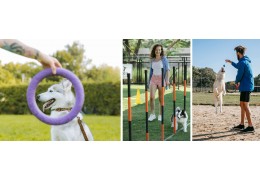Outdoor adventures with your pet can be exciting and rewarding, but proper training is essential for a safe and...
How to Train Your Pet for Outdoor Adventures
Embarking on outdoor adventures with your pet can be an enriching experience, fostering a deeper bond and promoting physical health for both of you. However, to ensure these excursions are enjoyable and safe, it's crucial to undertake proper dog training, establish effective recall training, and implement consistent leash training. These foundational skills not only enhance your pet's behavior but also contribute to a harmonious outdoor experience.
Understanding the Importance of Training for Outdoor Activities
Training your pet for outdoor adventures is not merely about obedience; it's about safety, confidence, and mutual enjoyment. A well-trained dog is less likely to encounter hazards, disturb wildlife, or become a nuisance to others. Moreover, training strengthens the trust between you and your pet, making each adventure more rewarding.
1. Establishing Basic Obedience Commands
Before venturing into the wild, ensure your dog has mastered basic obedience commands such as "sit," "stay," "come," and "heel." These commands are the foundation of good behavior and are essential in unpredictable outdoor environments.
• Sit and Stay: These commands are crucial when you need your dog to remain stationary, preventing them from running into dangerous situations.
• Come (Recall): A reliable recall is vital. It ensures your dog returns to you promptly, especially when off-leash or in distracting environments.
• Heel: Teaching your dog to walk calmly by your side prevents pulling and ensures controlled movement through various terrains.
Common Myths About Microchipping Pets
1. “Microchips Have GPS Tracking”
A pet microchip for travel does not have GPS capabilities. It only provides identification when scanned by a microchip reader. For real-time tracking, you may need a separate GPS collar.
2. “Microchipping is Painful for Pets”
The implantation process is quick and relatively painless. Most pets do not react any differently than they would to a routine shot.
3. “Microchips Can Be Easily Removed”
A microchip for pets is designed to stay in place permanently. It is very difficult to remove without veterinary intervention.
4. “All Microchips Work Internationally”
Not all pet microchip for travel devices are compatible worldwide. Always check if your pet’s microchip meets the ISO standard required by your destination country.
2. Leash Training
Effective leash training is paramount for outdoor adventures. A dog that walks politely on a leash is easier to manage and poses less risk to themselves and others.
• Start Indoors: Begin leash training in a distraction-free environment. Allow your dog to get accustomed to the leash and collar, rewarding calm behavior.
• Short Sessions: Keep initial training sessions brief to maintain your dog's interest and prevent frustration.
• Positive Reinforcement: Reward your dog with treats and praise when they walk beside you without pulling. Consistency is key to reinforcing good behavior.
• Gradual Progression: Once your dog is comfortable indoors, gradually introduce outdoor environments, increasing the level of distractions slowly.
3. Recall Training
A strong recall training command is essential for your dog's safety during outdoor activities. It allows you to call your dog back promptly, preventing potential dangers.
• High-Value Rewards: Use treats or toys that your dog finds irresistible to encourage a swift return when called.
• Consistent Cue: Use a distinct word or whistle for the recall command, ensuring it is unique and not used in other contexts.
• Practice in Various Environments: Start in low-distraction areas and gradually increase the complexity of the environment as your dog becomes more reliable.
• Avoid Negative Associations: Never scold your dog upon return, even if they were slow to respond. You want them to associate coming back to you with positive experiences.
4. Socialization
Proper socialization is crucial for your dog's confidence and behavior during outdoor adventures. Exposure to various environments, people, and other animals reduces anxiety and promotes adaptability.
• Puppy Socialization Classes: Enroll your young dog in classes to expose them to different stimuli in a controlled setting.
• Controlled Exposure: Gradually introduce your dog to new environments, ensuring each experience is positive and not overwhelming.
• Meet and Greets: Arrange controlled meetings with other dogs and people to build positive associations and proper social behavior.
5. Building Physical Stamina
Outdoor adventures often require physical endurance. Gradually build your dog's stamina to prepare them for longer excursions.
• Regular Exercise: Engage in daily physical activities, gradually increasing intensity and duration.
• Monitor Health: Ensure your dog is in good health before embarking on strenuous activities. Regular veterinary check-ups are essential.
• Paw Care: Condition your dog's paws for various terrains to prevent injuries. Start with short walks on different surfaces to build resilience.
6. Mental Stimulation
Mental fitness is as important as physical fitness. Engage your dog in activities that challenge their mind, promoting problem-solving skills and reducing boredom.
• Interactive Toys: Use puzzle toys that require your dog to think and work for treats.
• Training Games: Incorporate games that challenge your dog's cognitive abilities, such as hide and seek or scent work.
• Environmental Enrichment: Allow your dog to explore new environments, providing sensory stimulation through different sights, sounds, and smells.
7. Safety Measures
Ensuring safety during outdoor adventures is paramount. Preparation and awareness can prevent accidents and keep your dog secure.
• Identification: Ensure your dog wears a collar with an ID tag and is microchipped with up-to-date information.
• First Aid Knowledge: Learn basic first aid for dogs to handle minor injuries or emergencies during outings.
• Weather Considerations: Be mindful of weather conditions. Avoid extreme temperatures and provide appropriate gear, such as cooling vests or jackets, to keep your dog comfortable.
8. Gear and Equipment
Investing in proper gear enhances safety and comfort during outdoor activities. Choose equipment suited to your dog's size, breed, and the nature of the adventure.
• Harnesses: A well-fitted harness provides better control and reduces strain on your dog's neck.
• Leashes: Use sturdy leashes appropriate for the activity. Consider hands-free options for activities like running or hiking.
• Booties: Protect your dog's paws from rough terrains, hot surfaces, or sharp objects.
9. Training for Specific Outdoor Activities
If you plan on engaging in specific outdoor activities, tailor your training to suit those needs.
• Hiking: Train your dog to walk on narrow trails, stay close, and respond to commands even in exciting environments.
• Camping: Teach your dog to settle in a tent, stay calm around wildlife, and follow campsite etiquette.
• Swimming: Gradually introducing Swimming to your pets.












